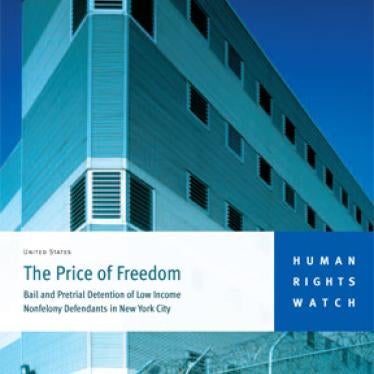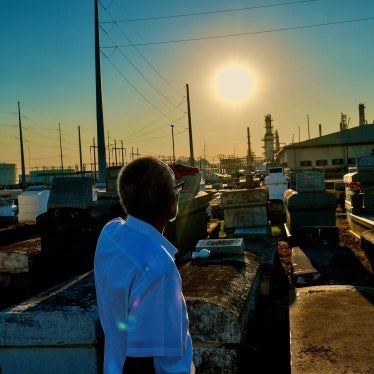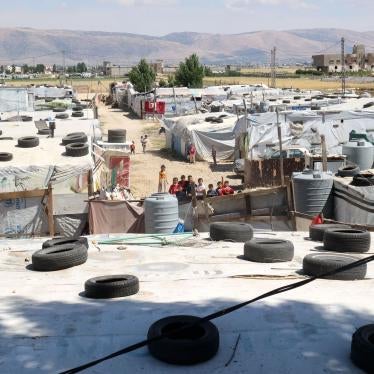Jonathan Lippman
Chief Judge of the State of New York
New York State Unified Court System
Office of Court Administration, Rm. 852
25 Beaver Street
New York, NY 10004
Via USPS
Dear Chief Judge Lippman:
I am writing in response to the bail initiative you outlined in your recent State of the Judiciary address and to the bail reform legislation recently introduced at your request by Senator Nozzolio, S.4483, and by Assemblyman Lentol, A.6799, which incorporate your reform proposals.[1] Human Rights Watch agrees with you that defendants should not lose their liberty in pretrial detention simply because they are too poor to afford bail. We strongly believe that limiting pretrial detention protects the integrity of the judicial system and human rights without risking public safety. It also saves the taxpayer from unnecessary public expenditures.
While the legislation that has been introduced may prove a useful starting point for reform of New York’s bail laws, it is far from adequate as currently drafted. Most importantly, it lacks essential safeguards for defendants’ rights. Instead of a detailed critique of each provision of the bills—which, quite frankly, we think would be premature at this stage in the legislative process— we offer instead recommendations for you and other stakeholders to consider. We believe if incorporated into legislation, our recommendations would help ensure the New York criminal justice system fully respects the presumption of innocence, does not discriminate on the basis of financial resources, and does not impose disproportionate and unnecessary burdens on defendants who remain in the community pending disposition of their cases.
We welcome legislation that will prevent indigent defendants from being incarcerated, pending disposition of their case, simply because of their poverty. As we documented in our report, The Price of Freedom: Bail and Pretrial Detention of Low Income Nonfelony Defendants in New York City, when New York City judges do not release nonfelony defendants pretrial on their own recognizance, they almost always set bail in the form of cash or insurance bond, rarely utilizing alternative forms of bail authorized by New York law that are far less financially onerous.[2] Moreover, judges often set bail at amounts low income defendants cannot afford. In New York City, according to our research, almost 9 out of 10 (87 percent) of nonfelony defendants with bail set at $1,000 or less could not post bail and were subjected to pretrial detention for an average of two weeks.
The New York City Criminal Justice Agency provides illuminating data regarding bail in New York City for felony and nonfelony defendants. Their Annual Report for 2011 indicates that bail was set that year in 30 percent of the cases that were not disposed at arraignment; in 61% of those cases, bail was set at $1,001 and higher, and only 12 percent of the defendants in those cases were able to post bail at arraignment.[3]
Wholly apart from new legislation, much can be done under existing law if judges, prosecutors, and defense attorneys act vigorously to ensure defendants are not incarcerated pretrial for want of funds to buy their freedom. Most importantly, far greater use could and should be made of the alternative bail forms authorized by New York law, N.Y. CPL Law § 520.10. We urge you to use all available means at your disposal to encourage the judiciary to use these alternatives to cash or insurance bonds when they are setting bail.
We turn now to our recommendations for key provisions that New York bail reform legislation should include.
1) New York law should contain an express presumption that defendants shall be released on their own recognizance. The legislation should further specify that the presumption may only be overcome by clear and convincing evidence that financial or other conditions are required in a particular case to ensure the defendant’s return to court and/or to protect public safety. This presumption of release— which is required to reflect the presumption of innocence—should apply to felony as well as nonfelony defendants.
2) With regard to ensuring a defendant’s return to court, New York law should instruct judges that they should only impose bail or other pretrial release conditions on defendants who pose a high likelihood —as reflected in evidence-based criteria—of otherwise failing to return. All too often, severity of the offense and/or prior criminal record is used as a proxy for likelihood of not returning to court. We are not aware, however, of data that show a correlation between the nature or severity of the offense charged or prior convictions and failure to return of New York defendants.
3) If New York law is amended to include public safety as a consideration in pretrial release decisions, the law should specify that public safety for pretrial release purposes may not be considered for nonfelony defendants accused of offenses that are neither violent nor threaten violence. If the definition of public safety is not so constrained, then any and all unlawful acts, however minor or non-dangerous, could be taken into consideration in pretrial release decisions under the guise of protecting the public and the exception could swallow the presumption of pretrial release on the defendant’s own recognizance. For similar reasons, the law should specify that public safety may not be taken into account for felony defendants in making pretrial release decisions except when the defendant is accused of a felony that has deprived or threatened to deprive other persons of their lives, physical integrity, or a significant amount of property. Being charged with selling drugs to an adult customer, for example, should ordinarily not be considered a crime that triggers application of public safety considerations in determining pretrial release conditions. Public safety, that is, should not be defined as synonymous with any unlawful conduct. It might prove helpful in the legislation to list the specific nonfelony and felony offenses that would be considered within this public safety consideration.
4) New York law should expressly provide that when release on recognizance is denied, judges must choose the least onerous amount and form of bail and/or the least restrictive conditions of pretrial release consistent with ensuring the defendant’s return to court and, where appropriate, protection of public safety. Both the amount and form of bail and the nature of any non-financial conditions of release must be tailored to the individual defendant, taking into consideration the offense charged, the defendant’s financial resources, his or her prior criminal record, demonstrated willingness to return to court in other cases, family and community ties, work and educational history, and other factors that are correlated with return to court and, where appropriate, public safety. The law should also require judges to consider all forms of bail authorized by the legislature, and not consider only cash bail and insurance bonds.
5) New York pretrial release law should be amended to conform to the American Bar Association standards for pretrial release (American Bar Association, ABA Criminal Justice Standards: Pretrial Release, 3rd ed., 2007) or federal law regarding pretrial release (18 U.S. C. §3142). Both standards reflect the fundamental principle that no one should be incarcerated pretrial simply because they cannot afford a financial condition of release —whether it be imposed to ensure return to court or to protect public safety. New York law should expressly state that courts may not impose bail in a form or amount that would result in pretrial detention solely due to the defendant’s inability to pay. Judges have a range of possible pretrial conditions, wholly apart from forms of money bail, which they could impose to ensure return to court or to protect public safety.
6) New York law should specify that if pretrial detention is ordered, there must be a hearing within a matter of days, e.g. no more than five, during which the burden is on the state to establish by clear and convincing evidence that there is no less restrictive way short of incarceration of ensuring the defendant’s return to court or of protecting public safety. Such a hearing should not be delayed to allow the government to secure evidence; if the government cannot establish the necessity of incarceration within the time period, the defendant should be released, without prejudice to the state’s ability to return to court in the future to seek a detention order.
7) New York law should specify that conditions of release, including pretrial supervision, should not be broader than that which is required to serve their limited purpose of ensuring return to court or protecting public safety. If reminder phone calls will suffice to ensure the defendant’s return to court, weekly meetings with a counselor should not be required. While some pretrial supervision programs or release conditions may offer benefits to defendants, e.g. substance abuse treatment, such benefits should be available for defendants to choose voluntarily and not as a condition of their pretrial freedom. The criminal justice system should not be used to force pretrial defendants who are presumed innocent into programs or treatment, however well-meaning and even beneficial such programs may be.
8) In cases in which release on recognizance is denied, the law should require the judge to articulate publicly and orally at court, however briefly, the specific reasons for the denial and the bases for the form and amount of bail or the specific pretrial release conditions that he or she imposed. Even though such a brief oral statement may add to the time it takes for each defendant’s arraignment, it will add much needed transparency and accountability to judicial pretrial release decisions.
As you can see from the above recommendations, we believe much work is needed to craft bail reform legislation for New York that will protect human rights and public safety. In our judgment, S. 4483 and its counterpart A. 6799 lack the necessary protections for defendants that are reflected in our recommendations.
We hope you find these recommendations useful. We would welcome the opportunity to discuss them with you if your schedule permits a meeting.
Sincerely,
Jamie Fellner, Esq.
Senior Advisor, US Program
Human Rights Watch
CC: Senator Michael Nozzolio
Albany Office
188 State Street, Room 503, Capitol Building
Albany, NY 12247
Assemblyman Joseph Lentol
Albany Office
LOB 632
Albany, NY 12248
[2] Human Rights Watch, The Price of Freedom: Bail and Pretrial Detention of Low Income Nonfelony Defendants in New York City, December 3, 2010, https://www.hrw.org/reports/2010/12/02/price-freedom.
[3] New York City Criminal Justice Agency, “Annual Report 2011,” December 2012, http://www.cjareports.org/reports/annual11.pdf (accessed April 17, 2013).







